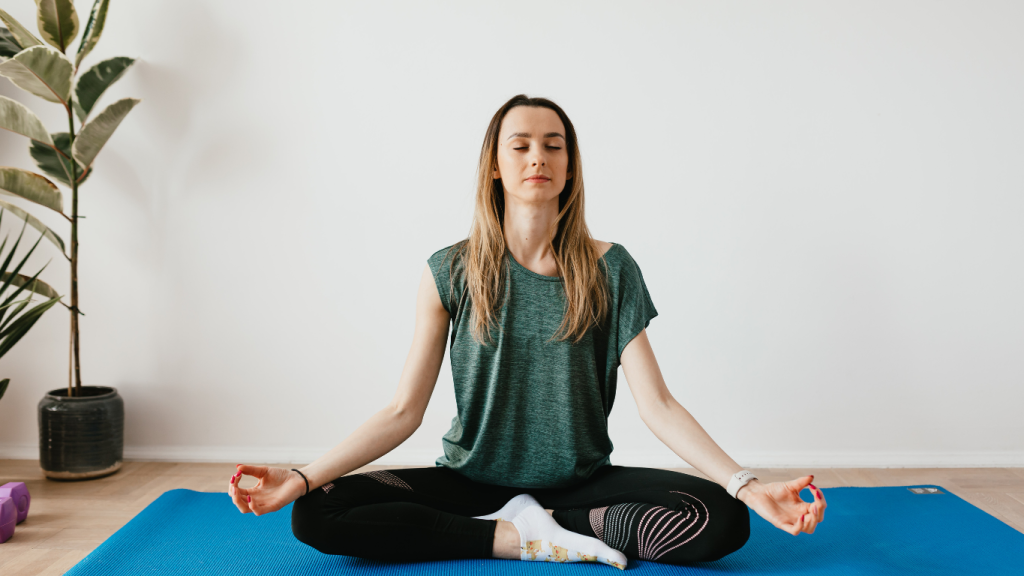Your mind is racing. Your to-do list is a mile long. You’re stuck in a loop of worrying about the future or replaying the past. You’ve probably heard about “mindfulness” or “meditation,” but it feels intimidating, complicated, or just… “not for you.”
What if it wasn’t complicated at all? What if you could start to feel calmer in just two minutes a day?
Welcome to the Health and Wellness Hub. We believe that mental wellness is the foundation for physical health. This expert guide provides the direct answers you need to de-mystify mindfulness and build a practice that works for your life.

The Core Problem: De-mystifying the Practice
What’s the real difference between “Mindfulness” and “Meditation”?
This is the most common (and best) question! They are related, but different.
- Mindfulness is the informal practice of being fully aware of the present moment, without judgment. You can practice mindfulness right now while washing the dishes—feeling the warm water, smelling the soap.
- Meditation is the formal practice of training your attention. This is when you intentionally set aside 5 or 10 minutes to sit and focus on a single anchor (like your breath).
Think of it this way: Meditation is the “workout” you do at the gym. Mindfulness is the “fitness” you use to walk and play all day long.
I’m not a monk. Is this just a “woo-woo” trend, or is it based on science?
It is 100% based on science. Mindfulness is a powerful tool for re-wiring your brain and calming your “fight-or-flight” response. When you practice, you are physically strengthening the parts of your brain responsible for focus and emotional regulation. You are also lowering your production of cortisol (the stress hormone), which reduces inflammation, lowers blood pressure, and signals to your entire body that it is safe to “rest and digest.”
The Action Plan: How to Start Right Now
I can’t “empty my mind.” My brain won’t shut up. How do I do it right?
This is the biggest myth of meditation. The goal is not to “empty your mind” or “stop your thoughts.” That’s impossible. Your brain’s job is to think!
The goal is to observe your thoughts without getting carried away by them.
- Your job is to sit and focus on your breath.
- Your mind will wander (to your to-do list, an email, what to have for dinner…).
- The moment you realize you’re thinking, you gently (and without judgment) bring your focus back to your breath.
That moment of “coming back” is the entire practice. You didn’t fail; you just did a “rep” for your brain.
How long do I have to do it for it to actually work?
Forget the idea of an hour. Start with two minutes. Seriously. The goal is consistency, not duration. Practicing for 2 minutes every single day is infinitely more powerful than practicing for 30 minutes once a month. Set a timer, sit down, and just focus on your breath. That’s it. That’s the whole start.
The Lifestyle: Integrating Mindfulness
I don’t have time to meditate. How can I be “mindful” in my busy life?
Use “habit stacking.” Find small “anchor” moments you already do every day and use them as a reminder to be mindful for 60 seconds.
- Your Morning Coffee: Before you take the first sip, just hold the warm mug. Feel its weight. Smell the aroma.
- Brushing Your Teeth: Instead of planning your day, just focus on the sensation of the bristles and the taste of the toothpaste.
- At a Red Light: Instead of grabbing your phone, just place your hands on the wheel. Feel your back against the seat. Take one deep breath.
- Washing Your Hands: Feel the water. Smell the soap.
How does this help my physical health, like sleep or nutrition?
It connects everything.
- Sleep: A mindful practice calms your nervous system and lowers cortisol, which allows your body to naturally produce melatonin and prepare for deep, restorative sleep.
- Nutrition: When you are mindful, you slow down. You’re no longer “stress-eating” on autopilot. You’re more aware of your body’s real energy and hunger cues.
- Movement: Mindfulness is the core of practices like yoga, but it also helps you enjoy a simple walk by being present instead of just trying to get it over with.
Your Brain Is a Tool. It’s Time to Tame It.
You don’t have to be controlled by your racing thoughts or your “fight-or-flight” anxiety. You have the power to find calm in the middle of the chaos.
Explore our Hub for more expert guides on how mindfulness connects to nutrition, sleep, and movement. Your journey to wellness starts with a single, simple breath.
